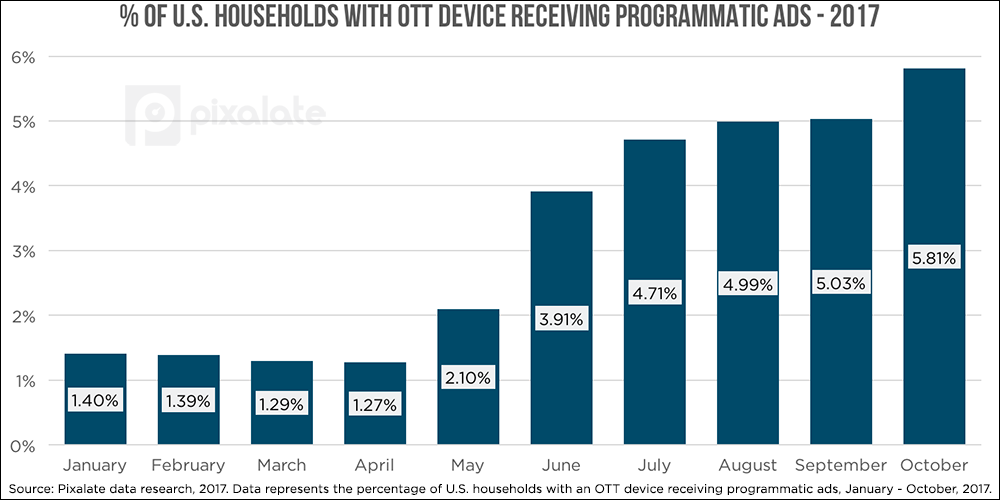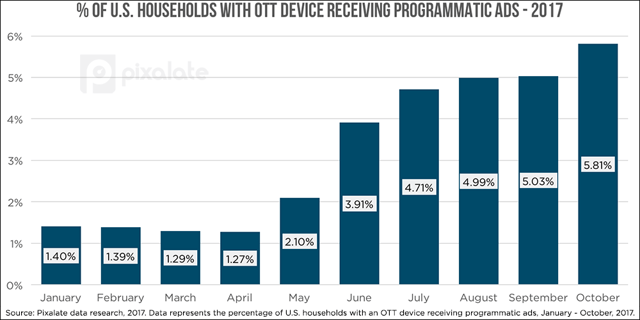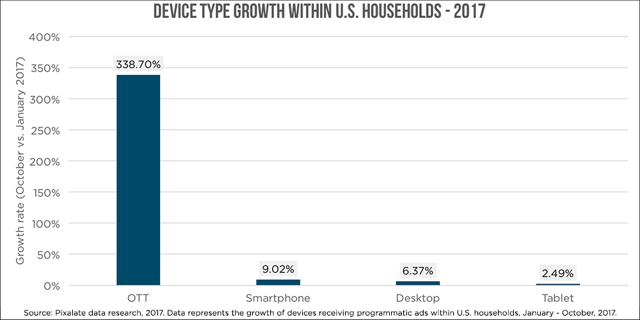
New Pixalate data reveals that 2017 was the year of the Connected TV/OTT device in the United States. The percentage of households with an active OTT device increased by 338.7% in 2017 — far more than any other common digital device.
Pixalate measured U.S. programmatic ad impressions throughout 2017 for this study. The “percentage of households” data represents the percentage of households in the United States that were served a programmatic ad via one of the four devices studied, including desktops, smartphones, tablets, and Connected TV/OTT devices.

In January 2017, only 1.4% of U.S. households had Connected TV/OTT device(s) that were receiving programmatic ads.
By October 2017, that number climbed to 5.81%, representing a growth of 4.41%.
While the number of U.S. households with OTT devices is still far lower than those with desktops, smartphones, and tablets, the OTT segment is growing the fastest.
The 4.41% growth seen by OTT devices far outstripped smartphones (up 2.45%), desktops (stagnant), and tablets (stagnant).

The raw number of U.S. households with a Connected TV/OTT device (receiving programmatic ads) increased nearly 339% from January-October 2017.
This easily paced all other devices studied. In fact, no other device even saw double-digit growth.
Want more data-driven insights? Sign up for our blog!
*By entering your email address and clicking Subscribe, you are agreeing to our Terms of Use and Privacy Policy.
These Stories on Thought Leadership
*By entering your email address and clicking Subscribe, you are agreeing to our Terms of Use and Privacy Policy.

Disclaimer: The content of this page reflects Pixalate’s opinions with respect to the factors that Pixalate believes can be useful to the digital media industry. Any proprietary data shared is grounded in Pixalate’s proprietary technology and analytics, which Pixalate is continuously evaluating and updating. Any references to outside sources should not be construed as endorsements. Pixalate’s opinions are just that - opinion, not facts or guarantees.
Per the MRC, “'Fraud' is not intended to represent fraud as defined in various laws, statutes and ordinances or as conventionally used in U.S. Court or other legal proceedings, but rather a custom definition strictly for advertising measurement purposes. Also per the MRC, “‘Invalid Traffic’ is defined generally as traffic that does not meet certain ad serving quality or completeness criteria, or otherwise does not represent legitimate ad traffic that should be included in measurement counts. Among the reasons why ad traffic may be deemed invalid is it is a result of non-human traffic (spiders, bots, etc.), or activity designed to produce fraudulent traffic.”

